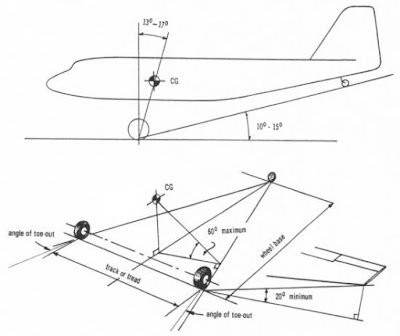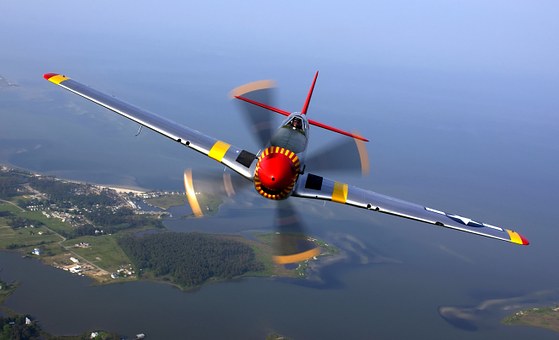Aircraft Landing Gear
Why do aircraft have only three landing gear? Why not four?
Most aircraft today have three landing gear. Two main landing gear struts located near the middle of the aircraft usually support about 90% of the plane's weight while a smaller nose strut supports the rest. This layout is most often referred to as the "tricycle" landing gear arrangement. However, there are numerous other designs that have also been used over the years, and each has its own advantages and disadvantages. Let's take a closer look at the various undercarriage options available to engineers.

Tail-wheel or Tail-dragger :
Gear Though the tricycle arrangement may be most popular today, that was not always the case. The tail-wheel undercarriage dominated aircraft design for the first four decades of flight and is still widely used on many small piston-engine planes. The tail-dragger arrangement consists of two main gear units located near the center of gravity (CG) that support the majority of the plane's weight. A much smaller support is also located at the rear of the fuselage such that the plane appears to drag its tail, hence the name. This tail unit is usually a very small wheel but could even be a skid on a very simple design.
What makes this form of landing gear most attractive is its simplicity. The gear are usually relatively lightweight, and the two main gear can also be easily encased in streamlined fairings to produce low drag in flight. Another potential advantage results from the fact that the plane is already tilted to a large angle of attack as it rolls down the runway. This attitude helps to generate greater lift and reduce the distance needed for takeoff or landing. This attitude is also an advantage on propeller-driven planes since it provides a large clearance between the propeller tips and the ground. Furthermore, tail-dragger planes are generally easier for ground personnel to maneuver around in confined spaces like a hangar.
 However, the greatest liability of this landing gear layout is its handling characteristics. This design is inherently unstable because the plane's center of gravity is located behind the two main gear. If the plane is landing and one wheel touches down first, the plane has a tendency to veer off in the direction of that wheel. This behavior can cause the aircraft to turn in an increasingly tighter "ground loop" that may eventually result in scraping a wingtip on the ground, collapsing the gear, or veering off the runway. Landing a tail-dragger can be difficult since the pilot must line up his approach very carefully while making constant rudder adjustments to keep the plane on a straight path until it comes to a stop. Many tail-dragger designs alleviate these handling problems by fitting a tail-wheel that can be locked instead of swiveling on a castor. Locking the tail-wheel helps keep the plane rolling in a straight line during landing.
However, the greatest liability of this landing gear layout is its handling characteristics. This design is inherently unstable because the plane's center of gravity is located behind the two main gear. If the plane is landing and one wheel touches down first, the plane has a tendency to veer off in the direction of that wheel. This behavior can cause the aircraft to turn in an increasingly tighter "ground loop" that may eventually result in scraping a wingtip on the ground, collapsing the gear, or veering off the runway. Landing a tail-dragger can be difficult since the pilot must line up his approach very carefully while making constant rudder adjustments to keep the plane on a straight path until it comes to a stop. Many tail-dragger designs alleviate these handling problems by fitting a tail-wheel that can be locked instead of swiveling on a castor. Locking the tail-wheel helps keep the plane rolling in a straight line during landing.Another disadvantage of the tail-dragger is poor pilot visibility during taxiing since he is forced to peer over a nose that is tilted upward at a steep angle. It is also often difficult to load or unload heavy cargoes because of the steep slope of the cabin floor. Similarly, pilots and passengers are forced to walk uphill during boarding and downhill after arrival. Many aircraft also rely on gravity to bring fuel from tanks to the engine, and some planes have been known to have difficulty starting the engine because it is uphill from the fuel supply.
 |
| DC-3 Dakota airliner illustrating its tail-dragger landing gear |
Good examples of tail-dragger aircraft include the Spitfire and DC-3 of World War II.
Tricycle or Nosewheel Gear
Now the most popular landing gear arrangement, the tricycle undercarriage includes two main gear just aft of the center of gravity and a smaller auxiliary gear near the nose.
The main advantage of this layout is that it eliminates the ground loop problem of the taildragger. This arrangement is instead a stable design because of the location of the main gear with respect to the center of gravity. As a result, a pilot has more latitude to
land safely even when he is not aligned with the runway.
 |
| Tricycle or nose wheel landing gear |
Furthermore, the tricycle arrangement is generally less demanding on the pilot and is easier to taxi and steer. The tricycle gear also offers much better visibility over the nose as well as a level cabin floor to ease passenger traffic and cargo handling. A further plus is that the aircraft is at a small angle of attack so that the thrust of the engine is more parallel to the direction of travel, allowing faster acceleration during takeoff. In addition, the nose wheel makes it impossible for the plane to tip over on its nose during landing, as can sometimes happen on tail-draggers.
The greatest drawback to tricycle gear is the greater weight and drag incurred by adding the large nosewheel strut. Whereas many taildraggers can afford to use non-retracting gear with minimal impact on performance, planes with nosewheels almost always require retraction mechanisms to reduce drag. Some planes with tricycle gear also have difficulty rotating the nose up during takeoff because the main wheels are located so close to the elevator, and there may be insufficient control effectiveness. Similarly, the closeness to the rudder reduces its effectiveness in counteracting crosswinds.
Another critical factor when designing tricycle gear is to properly balance the load carried by the main gear versus the nosewheel. Too little load on the main wheels reduces their braking effectiveness while too little on the nosewheel reduces its steering effectiveness. Careful balancing of weight is also important to prevent the plane from tipping back on its tail while at rest on the ground.
There are many examples of aircraft with tricycle landing gear, including the F-16 and Cessna 172.
Multi-Bogey Gear
A final variation that is worth mentioning is the use of multiple wheels per landing gear strut. It is especially common to place two wheels on the nose strut of the tricycle arrangment to provide safety and steering control in case of a tire blowout. This additional tire is particularly useful on carrier-based aircraft where two nosewheels are a requirement. Multiple wheels are also often used on main gear units for added safety, especially on commercial airliners.
When multiple wheels are placed on the same gear unit, they are attached together on a structural device called a bogey. The heavier the aircraft becomes, the more wheels are typically added to the bogey to spread the plane's weight more evenly across the runway pavement. In general, a plane weighing less than 50,000 lb (22,680 kg) has only one wheel per main gear strut. Aircraft weighing up to 200,000 lb (90,720 kg) usually carry two wheels per strut. On planes weighing up to 400,000 lb (181,440 kg), a four wheel bogey is typical. Aircraft of greater weight often carry four bogeys, each with four to six wheels.
The best examples of multi-bogey aircraft are large mega jets like the An-225. This mammoth cargo plane has seven pairs of wheels on each main gear assembly plus four nose wheels, combining for a total of 32 tires! Another good example is the Boeing 747. The 747 is equipped with four main gear units, each with four-wheel bogies, plus twin nose wheels so that the plane's weight is spread across 18 wheels.
Summary
Landing gear serves three primary purposes--to provide a support for the plane when at rest on the ground, to provide a stable chassis for taxiing or rolling during takeoff and landing, and to provide a shock absorbing system during landing. Regardless, all of these tasks are secondary to the plane's primary role as an efficient mode of travel through the air.
To aircraft designers, landing gear are nothing more than a necessary evil since planes are designed primarily for their performance in flight rather than on the ground. There have even been attempts over the years to eliminate landing gear entirely. The most extreme case was a study done by the Royal Navy to see if a jet plane could make a belly landing on the deck of an aircraft carrier coated with a rubberized surface. If successful, the method would eliminate the need for the very strong and heavy landing gear used on carrier-based aircraft. Unfortunately, the method proved impractical, but it shows the lengths some will go to while attempting to eliminate the need for landing gear!
We have seen that landing gear come in many varieties and each option has its own advantages and disadvantages. Selecting the best arrangement for a given aircraft is a trade-off between these strengths and weaknesses as they apply to the environment the plane is designed for. As a result, designers try to select the simplest, smallest, lightest, and least expensive solution possible to do the job while maintaining safety. That is why most planes only have three landing gear rather than four because fewer gear weigh less, require less structure aboard the plane, take up less space when retracted, and generate less drag.




Comments
Post a Comment